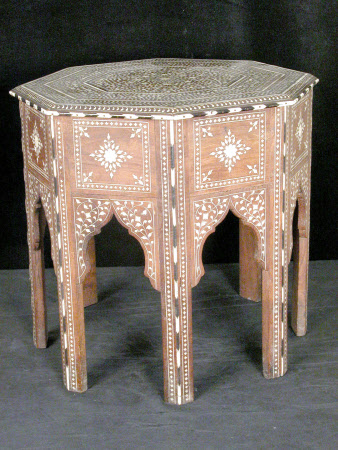Occasional table
Category
Furniture
Date
circa 1900 - 1930
Materials
Teak, ebony, bome
Measurements
42 x 41.5 cm
Place of origin
Hoshiarpur
Order this imageCollection
Wightwick Manor, West Midlands
NT 1288236
Summary
An octagonal occasional table, ebony- and bone-inlaid teak, Northern India, probably Hoshiarpur, early 20th century. The octagonal table top inlaid with a geometric pattern in white bone, a chequered design inlaid to the rim in plain and black-stained bone, on eight legs joined together with square panels cut-out to form ogee- or onion-shaped arches, the legs and frieze inlaid with bone lines, flower, leaves, and chequer-banding.
Full description
Tables such as this were inspired by examples imported into India from Cairo, which in turn derived from 16th Century Ottoman models. This particular example is typical of Hoshiarpur in the state of Punjab in Northern India. Furniture with this characteristic inlay was popular amongst British colonialists in India and, after appearing at international exhibitions from the middle of the 19th century, sparked a craze for 'Ottoman' interiors in Western Europe, and large numbers appear to have been made specifically for export. It is not known when this table was acquired, or how it came to be in the collection at Wightwick, but it is listed in the inventory taken there in 1937.
Provenance
In 1937, Sir Geoffrey Mander and his wife Rosalie gifted Wightwick Manor, its contents and gardens to the National Trust. Sir Geoffrey and his family continued to occupy and manage Wightwick adding to the collection in collaboration with the National Trust. Sir Geoffrey died in 1962 but Lady Mander continued to live at Wightwick until her death in 1988. This table is listed in the Wightwick Manor 1937 inventory.
References
Jaffer 2001 : Amin Jaffer, Furniture from British India and Ceylon, a catalogue of the collection in the Victoria and Albert Museum and the Peabody Essex Museum, London, V&A publications, 2001.
